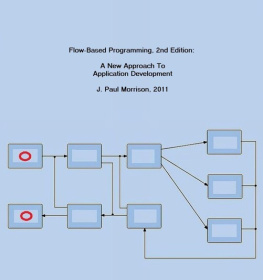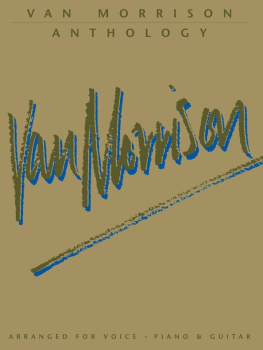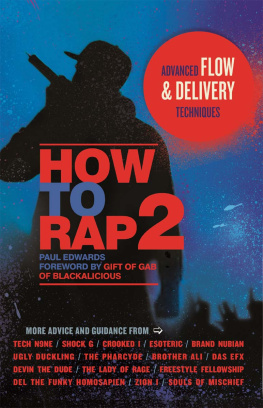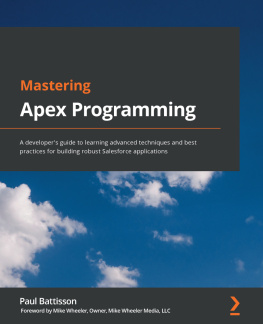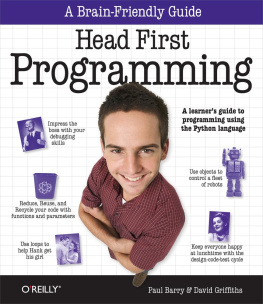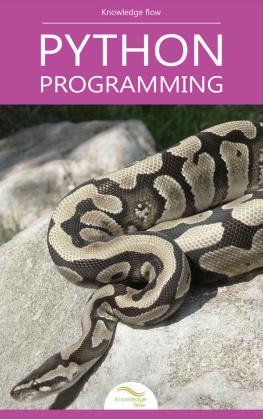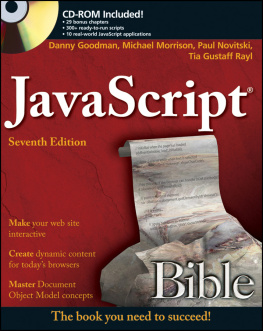J. Paul Morrison - Flow-Based Programming
Here you can read online J. Paul Morrison - Flow-Based Programming full text of the book (entire story) in english for free. Download pdf and epub, get meaning, cover and reviews about this ebook. year: 2011, genre: Computer. Description of the work, (preface) as well as reviews are available. Best literature library LitArk.com created for fans of good reading and offers a wide selection of genres:
Romance novel
Science fiction
Adventure
Detective
Science
History
Home and family
Prose
Art
Politics
Computer
Non-fiction
Religion
Business
Children
Humor
Choose a favorite category and find really read worthwhile books. Enjoy immersion in the world of imagination, feel the emotions of the characters or learn something new for yourself, make an fascinating discovery.
- Book:Flow-Based Programming
- Author:
- Genre:
- Year:2011
- Rating:3 / 5
- Favourites:Add to favourites
- Your mark:
- 60
- 1
- 2
- 3
- 4
- 5
Flow-Based Programming: summary, description and annotation
We offer to read an annotation, description, summary or preface (depends on what the author of the book "Flow-Based Programming" wrote himself). If you haven't found the necessary information about the book — write in the comments, we will try to find it.
Flow-Based Programming — read online for free the complete book (whole text) full work
Below is the text of the book, divided by pages. System saving the place of the last page read, allows you to conveniently read the book "Flow-Based Programming" online for free, without having to search again every time where you left off. Put a bookmark, and you can go to the page where you finished reading at any time.
Font size:
Interval:
Bookmark:
Flow-Based Programming,
2ND EDITION
[Page intentionally left blank]
Flow-Based Programming, 2ND EDITION:
A New Approach To
Application Development
J. Paul Morrison, 2011
Copyright 2010, 2011 by J.P. Morrison Enterprises, Ltd.
Author: J. Paul Morrison
ISBN: 1451542321
EAN-13: 9781451542325
Printed by CreateSpace, DBA of On-Demand Publishing LLC, part of the Amazon group of companies.
All rights reserved.
Information about 1st Edition (1994):
Copyright 1994 by van Nostrand Reinhold
Author: J. Paul Morrison
Library of Congress Catalog Card Number: 94-1822
ISBN: 0-442-1771-5
The following are trademarks or registered trademarks of International Business Machines, Inc.:
BMS CICS, CICS/ESA CMS CMS Pipelines CP/CMS DB2 DFDM DL/I GDDM GPSS IBM IMS, IMS/ESA, IMS TM ISPF | MFS MQSeries MVS, MVS/ESA PGF PL/I REXX RPG System/370 VM/XA VS/COBOL II VTAM |
The following are products of their respective suppliers:
C, C++ C# Java Linda Microsoft Works | Objective-C Smalltalk V/PM UNIX Phenom Pentium |
If any of the other products mentioned below are trademarked, hopefully it will be understood that there is no intent to infringe on the trademark.
This book describes a highly productive approach to application development, based on a new and significantly different programming paradigm, referred to as Flow-Based Programming (FBP). Although at least one very large application built using software based on these concepts has been in continuous use for about 20 years [as of 1994 over 35 now, in 2010], it is not well known to the programming community, so it will be novel to most of the readers of this book. During the time it has been under development and in use, it has been found to significantly enhance both the productivity of the programmers who use it and the reliability and maintainability of applications built with it.
The material described here has practical application to many of the problems that beset todays information technology industry. At the same time it has solid theoretical underpinnings and also strong affinities with a lot of other theoretical work going forward in universities and research institutions worldwide. A number of articles on this concept have appeared over the years in different publications, but they have been widely scattered and I feel that no single article has been able to do justice to the whole set of concepts. Therefore, it seems timely to assemble this material into a single book, thus allowing it to be presented as a coherent whole.
Flow-Based Programming provides a view of data processing that is consistent from the largest scale (e.g. organizations talking to other organizations) all the way down to the programming level, without the sudden changes of viewpoint characteristic of conventional programming. It can be used from early in the design stage all the way through to implementation, in a seamless manner. It is a good match with design techniques such as Structured Analysis, and with a number of implementation approaches, such as prototyping and incremental development. It is a natural reuse tool and strongly supports good programming disciplines. It has many non-procedural aspects, which give it many of the advantages of this type of code. It should not be surprising, therefore, that it has caught the interest of some of the most experienced people in our business. I feel strongly, and hope to prove in this book, that these concepts have the potential to save computer-using organizations significant amounts of money and, perhaps more importantly, to lay the foundations of a true software marketplace and programming discipline in the broadest sense.
This book is aimed at systems architects, software and hardware engineers, application developers and analysts, researchers in fact, everyone who is involved in computing or even just interested in the field. Educators should find that this book places a number of the advanced concepts of computing science into context in a natural way and perhaps will find this book of assistance in passing them on to their students.
This book is not intended to be a manual for any one piece of software, but as a fairly general introduction to a new and powerful set of concepts. Like object-oriented programming, FBP does involve a new programming paradigm, which profoundly changes the way programmers look at the process of constructing applications. Although a number of its concepts seem very different from conventional programming, there are many real-world analogies that help the reader make the transition to this new way of thinking about building systems. Also, once the basics have been mastered, most of the remaining material will follow naturally. It is interesting to note that, in the long run, FBP appears to be on a convergent path with the more advanced work in object-oriented programming. I also hope that this book might contribute somewhat towards bridging the present divide in the area of computer programming between business and academia.
Markham, ON, Canada, 1994
Since it has been about 15 years since the publication of the 1994 edition, and the industry is very different from where it was in those days, it seems timely to produce a new edition, which will try to capture some of the effects of the drastically changed computing environment on our thinking about Flow-Based Programming. Of course, there is much that has not changed, and FBP is still far ahead of the pack! One major difference, however, is that people all over the world are discovering its advantages, and in fact there are now a number of companies that have been explicitly set up to capitalize on these concepts.
This edition keeps most of the original chapters, but I have dropped quite a bit of material that I judge to be of little interest to 21st-century readers. In particular, there will be less emphasis on mainframe systems and software, as this does not seem to be an area where the new concepts are taking root. However, as I feel that number-crunchers will be around for quite a while longer, some of that material will be retained. There has been such an explosion of new material in the last few years that I hope my readers will forgive me if a certain patchiness results! Of course, the 1994 edition still remains available second-hand, and a PDF version of that edition is available at http://www.jpaulmorrison.com/fbp/book.pdf. As we have moved into an Internet world since my book was published, there is now a web site describing the concepts behind FBP at http://www.jpaulmorrison.com/fbp/, and a wiki with a lot of interesting comments and feedback at http://www.jpaulmorrison.com/cgi-bin/wiki.pl.
An article on FBP has been on Wikipedia for several years: http://en.wikipedia.org/w/index.php?title=Flow-based_programming&oldid=363964067. The latest version now reflects the chapter numbers in the current edition of this book.
All references to OOP have been changed to OO, which seems to have become the current usage.
In the previous edition there was an Appendix describing THREADS, an early C implementation. I have now expanded it to add high-level descriptions of two more recent ones, namely a Java implementation (JavaFBP) (http://www.jpaulmorrison.com/fbp/#JavaFBP) and a C# implementation (C#FBP) (http://www.jpaulmorrison.com/fbp/#CsharpFBP), and have reduced the amount of information on THREADS (http://www.jpaulmorrison.com/fbp/#THREADS), as this can still be found on the web site. THREADS is in process of being upgraded to use Windows fibres (Windows spells it fiber, but I am going to stay with the Canadian spelling in what follows), and there are some other minor changes to take advantage of the Microsoft C++ compiler.
Next pageFont size:
Interval:
Bookmark:
Similar books «Flow-Based Programming»
Look at similar books to Flow-Based Programming. We have selected literature similar in name and meaning in the hope of providing readers with more options to find new, interesting, not yet read works.
Discussion, reviews of the book Flow-Based Programming and just readers' own opinions. Leave your comments, write what you think about the work, its meaning or the main characters. Specify what exactly you liked and what you didn't like, and why you think so.

